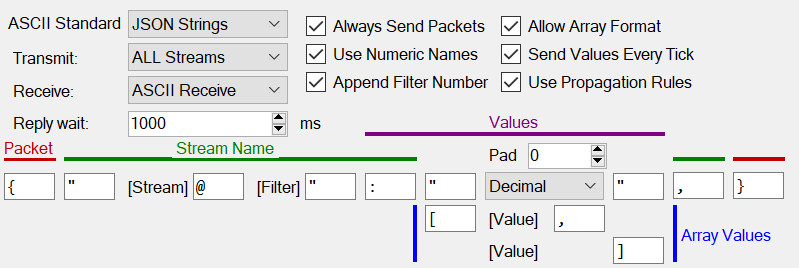ASCII Protocol Properties
The ASCII protocol provides a way of quickly configuring human-readable serial data. The main options are:
- ASCII Standard – some built in standards are provided for quick configuration. JSON is the default and provides industry compatible and readable data output.
- Always Send Packets – if ticked, the protocol will produce a data packet even if there is no data to transmit. For example, in JSON this would mean you would get the open/close brackets each tick even if they contain no data.
- Allow Array Format – higher frequency data can be transmitted in a block, an array. If this is not desired or permitted by the receiver, uncheck this box.
- Transmit: All Streams – when checked, the protocol will transmit ALL streams available in the system. This could result in a large amount of data. Using this option saves having to individually configure each stream. Any configured streams will override the default output. Configured streams can either specify the exact Filtered Stream (and therefore only apply to it) or use the Late Binding Flag (and apply to all matching streams but a wildcard filter).
- Send Values Every Tick – when checked, the current value will be resent even if no new value has been acquired by the system.
- Packet (red) – defines the character string used to identify the start and end of the packet.
- Stream (green) – defines the character strings used to delineate the stream identifier and stream/value separator.
- Values (purple) – defines the numerical padding (e.g. with padding of four the value twelve is transmitted as “0012”), the format of the number (decimal “12”, hexadecimal “AB” or Float “12.5”) and the character strings used to delineate the value.
- Array Values (blue) – defines how multiple values will be combined and what contains the array elements.
The feedback panel shows an example of how data will be transmitted with the current settings (it does not reflect the actual streams that may be configured or available).
Follow this external link for a table of ASCII characters and values as well as their traditional means.

